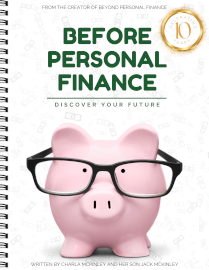I previously reviewed the Beyond Personal Finance course for teens and young adults. Before Personal Finance is designed for younger students who need to start at a more basic level. The publisher says the course is for ages 8 to 12, but I would be more inclined to use it with ages 11 and up who are studying personal finance for the first time.
The course is presented primarily through a single coursebook, but you also need the free, online resources available on the publisher’s website.
The course works somewhat like a simulation in that the students make several choices for their “Future You” regarding jobs, spending, saving, giving, and other financial transactions. These choices carry over from lesson to lesson. Future You is age 13 in the first lesson and one year older in each lesson—up to age 22 in the tenth lesson. This approach more realistically reflects the reality of long-term planning and the future impact of today’s decisions.
Students are not locked into their initial choices. If they have made choices that are heading them toward bankruptcy or the inability to save for essentials, they should go back and change the selected job, some of their choices, or the amounts they've chosen to budget for various items.
Just as both positive and negative events affect a person’s finances in real life, the course introduces chance elements through the online Plot Twist Wheel and an Insurance Claim Wheel, both found on the teacher resources page for this course.
Among the many topics covered in this course are budgeting banking, charitable donations, entrepreneurship, interest, credit cards, loans, taxes, the stock market, and insurance.
Each of the course’s ten lessons is preceded by a Teacher’s Corner page with tips for interacting with students and simple instructions for progressing through the lesson and making budget entries.
After the Teacher’s Corner, each lesson is divided into four main sections: teaching, activity, “scene,” and quiz.
The teaching section is a two-page spread with six boxes of information covering six topics. For instance, Lesson 2: Budgeting teaches about What is a Budget?, Income, Expenses, Giving, Saving, and Emergency Fund.
Next, students complete an activity with charts or graphic organizers. For instance, the activity for Lesson 4 has students research 10 commercials, identifying the product sold and the selling strategy for each. Parents are supposed to be involved, and you can see how fun this might be to do with the entire family.
The “scene” is where students add and delete budget items, always spinning the Plot Twist Wheel to discover which random element they will have to include.
A ten-question, multiple-choice quiz checks for comprehension. Answer keys are online at the teacher resource page.
Each lesson also includes a puzzle—e.g., a maze, a word search, a cryptogram—a different type for every lesson; a page titled “People Who Have Made a Difference,” with a short biography of someone connected to the financial world (e.g., Marco Polo, Warren Buffett); and a “Reflect” page with questions that help students evaluate “Future You” choices and budget decisions. Solutions to the puzzles are online. QR codes throughout the book make it easy to get to the teacher resource page quickly for answer keys and other resources.
High school students with some financial savvy should be able to work through the course independently much of the time, but parents should work with younger students, making sure they understand how to use the coursebook, discussing potential choices, and perhaps highlighting options they might miss. Parents might also assist students in revising previous choices that turned out to be unworkable.
Summary
Before Personal Finance is great as an introduction to personal finances. It provides the right amount of information for younger students without overwhelming them. The incorporation of personal budgeting and decision-making also helps students see the very practical applications of what they are learning.









